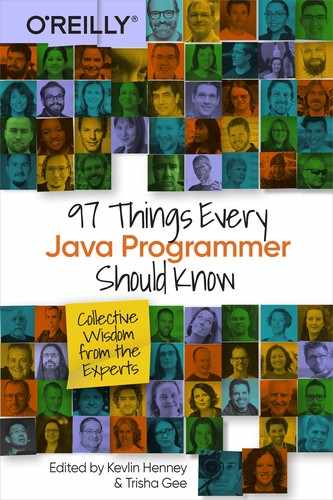Chapter 28. “Full-Stack Developer” Is a Mindset
Maciej Walkowiak

In 2007—the year I started working my first job as a Java developer—the spectrum of technologies involved in day-to-day web development was quite narrow. Relational databases were in most cases the only type of database a developer needed to know. Frontend development was limited to HTML and CSS, spiced with a bit of JavaScript. Java development itself meant primarily working with Hibernate plus either Spring or Struts. This set of technologies covered almost everything necessary for building applications at that time. Most Java developers were actually full-stack developers, though that term had not yet been coined.
Things have changed significantly since 2007. We started building more and more complex user interfaces and handling this complexity with advanced JavaScript frameworks. We now use NoSQL databases, and almost every one of them is very different from the others. We stream data with Kafka, message with RabbitMQ, and do a lot more. In many cases, we also are responsible for setting up or maintaining the infrastructure with Terraform or CloudFormation, and we use or even configure Kubernetes clusters. Overall complexity has grown to the point that we have separate positions for frontend developer, backend developer, and DevOps engineer. Is it still possible to be a full-stack developer? That depends on how you understand the term.
You can’t be an expert in everything. Considering how much the Java ecosystem has grown, it’s hard to even be an expert in Java itself. The good thing is that you don’t have to be one. For many projects, especially in smaller companies, the most beneficial team setup is when each area of expertise is covered by at least one expert, but these experts don’t limit themselves to working only on that one area. Developers specialized in developing backend services can write frontend code—even if the code isn’t perfect—and the same thing goes for frontend developers. This helps move projects forward more quickly, as one person can develop a change that requires touching every layer of the application. It also leads to greater engagement during refinement meetings, as there are no tasks isolated only to a certain group of people.
Most importantly, not being strictly limited to one area changes how you approach tasks. There are no “It’s not my job” discussions anymore—developers are encouraged to learn. Having one person go on vacation is not an issue because there are always others who can cover for them—maybe not as efficiently, and maybe with results that aren’t quite as good, but enough to keep things moving forward. It also means that when there is a need to introduce a new technology to the stack, you don’t need to find a new team member, because existing team members are already comfortable leaving the comfort zone of their expertise.
Full-stack developer is therefore a mindset. It’s being senior and junior at the same time, with a can-do attitude.
